
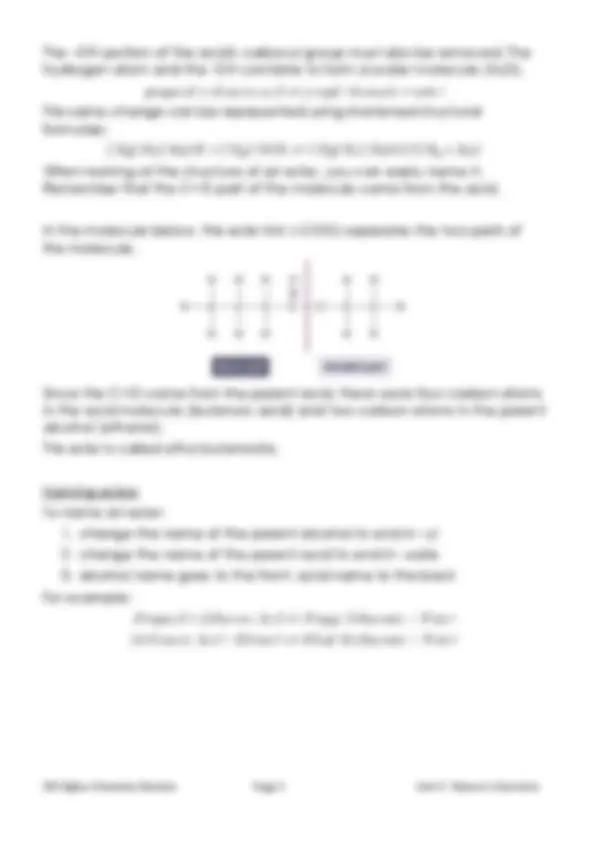
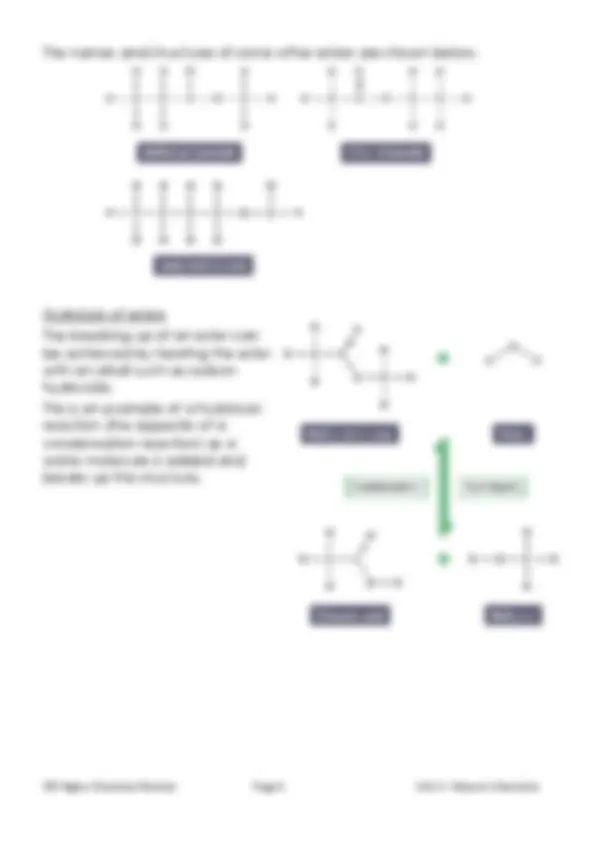
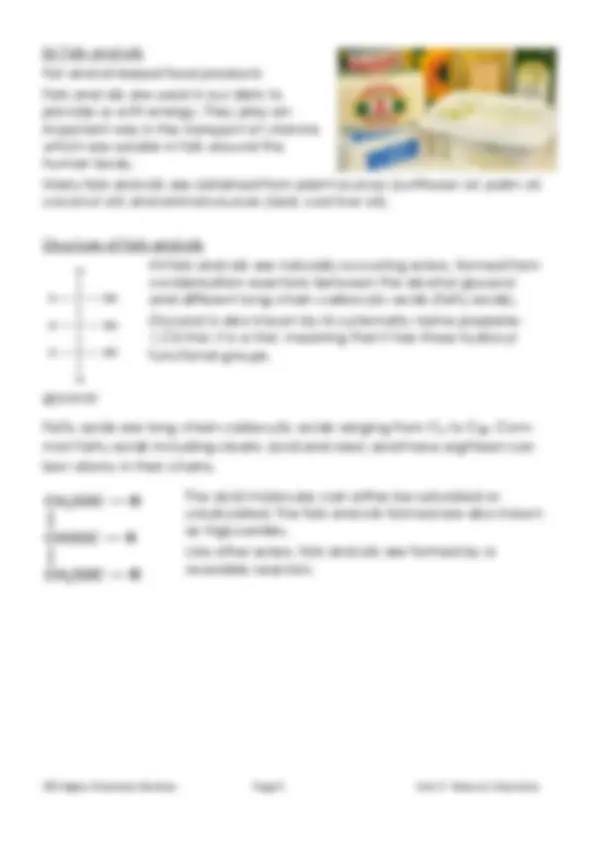
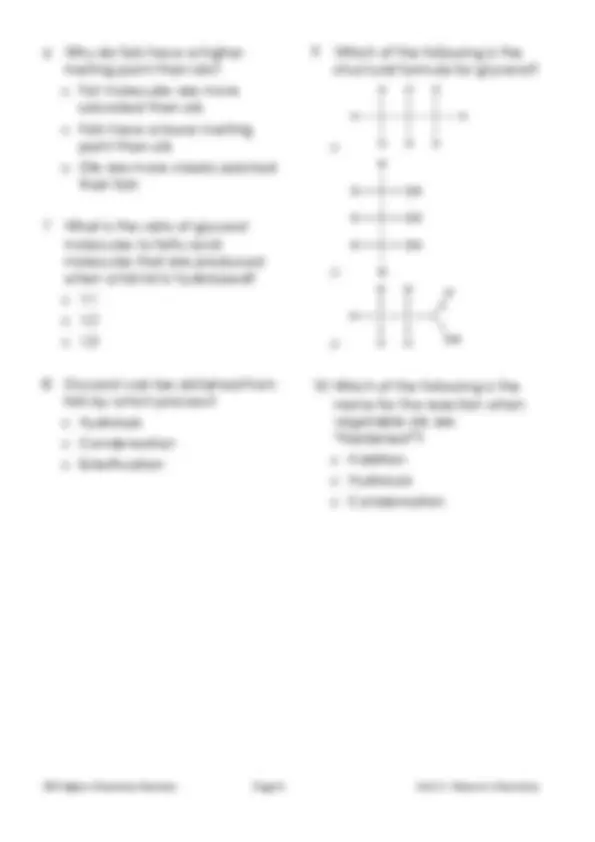
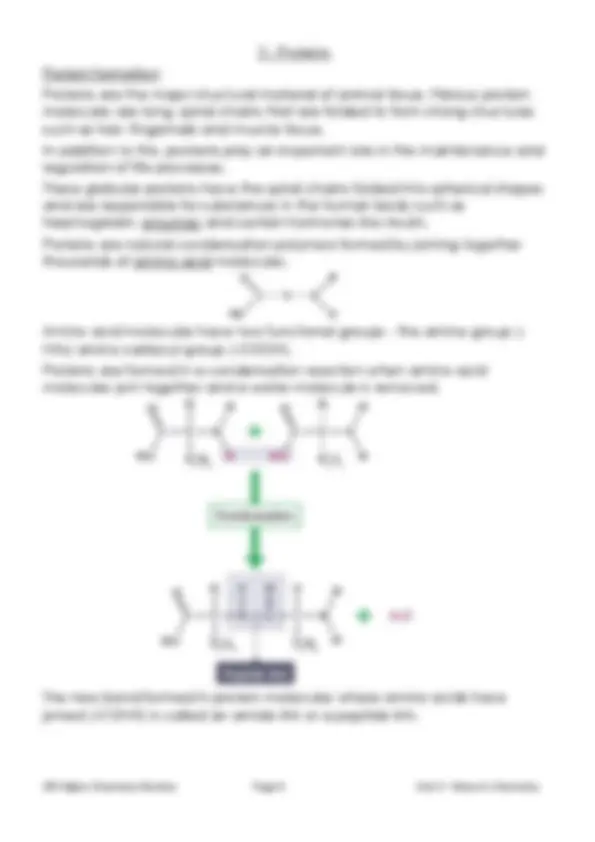
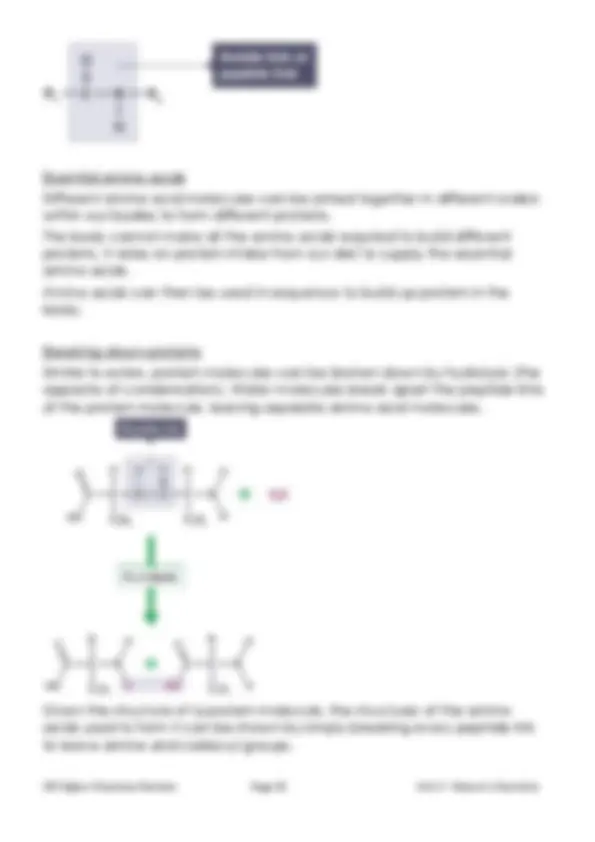
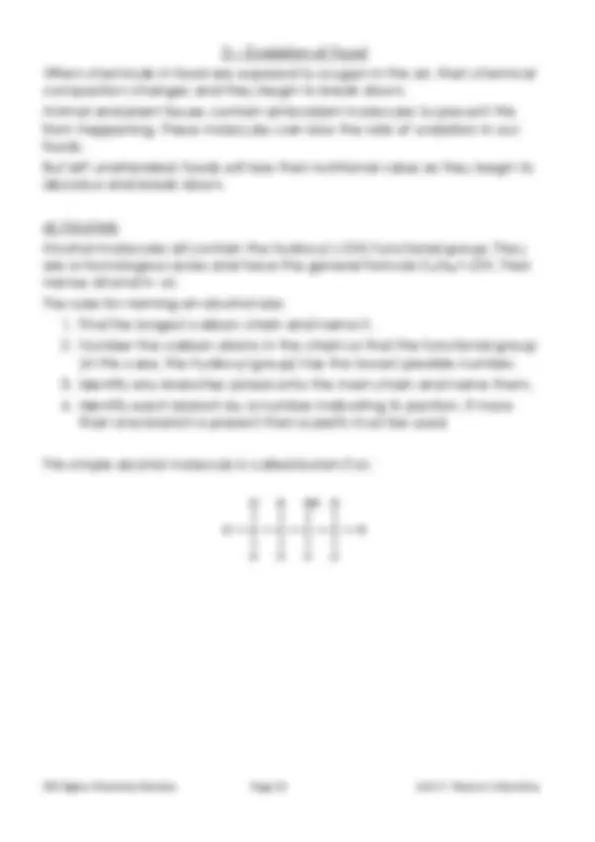
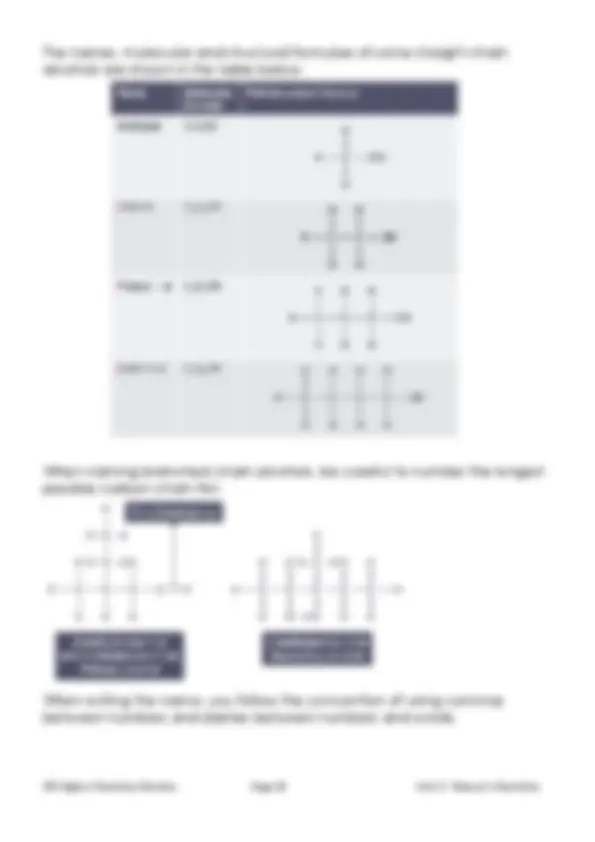
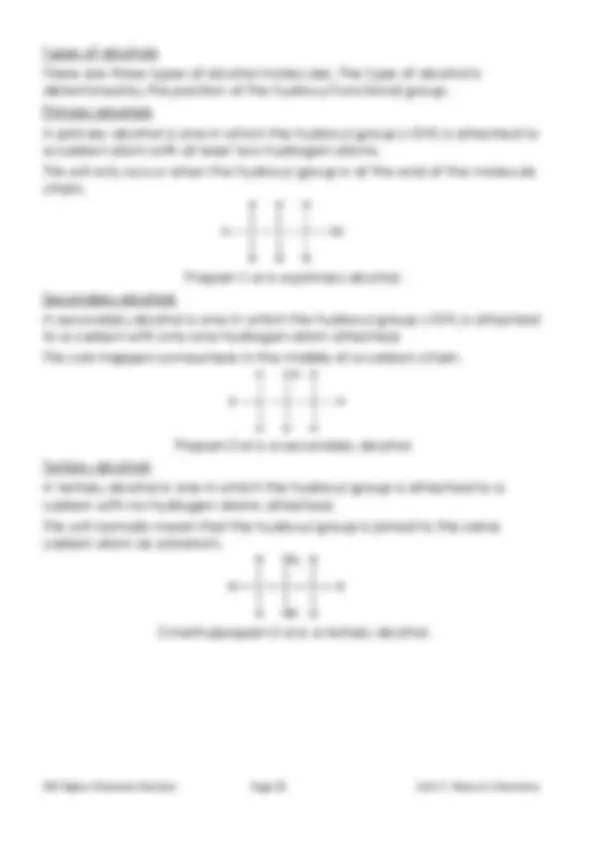
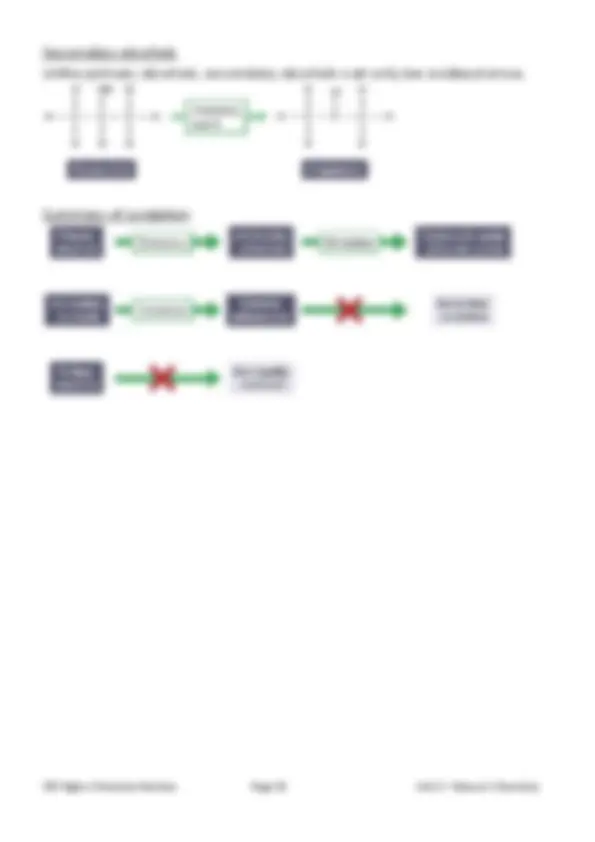
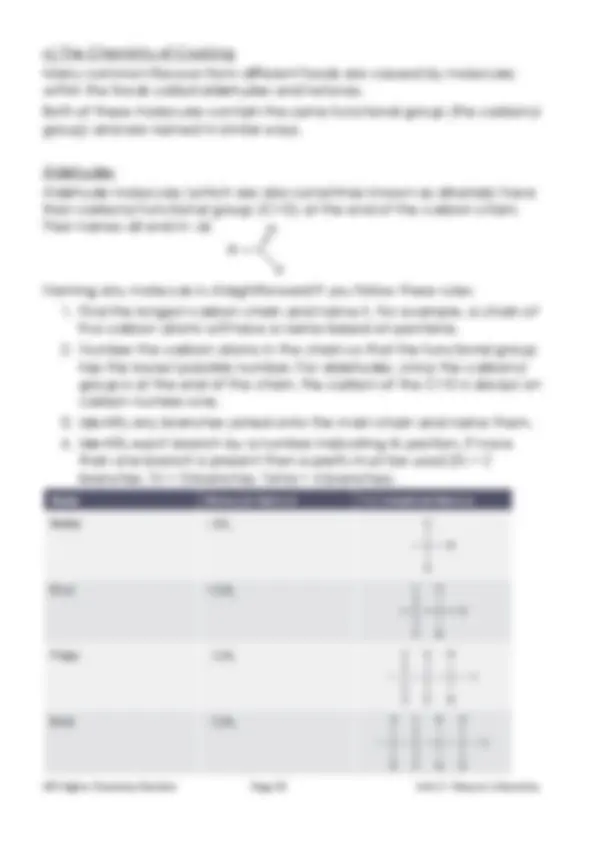
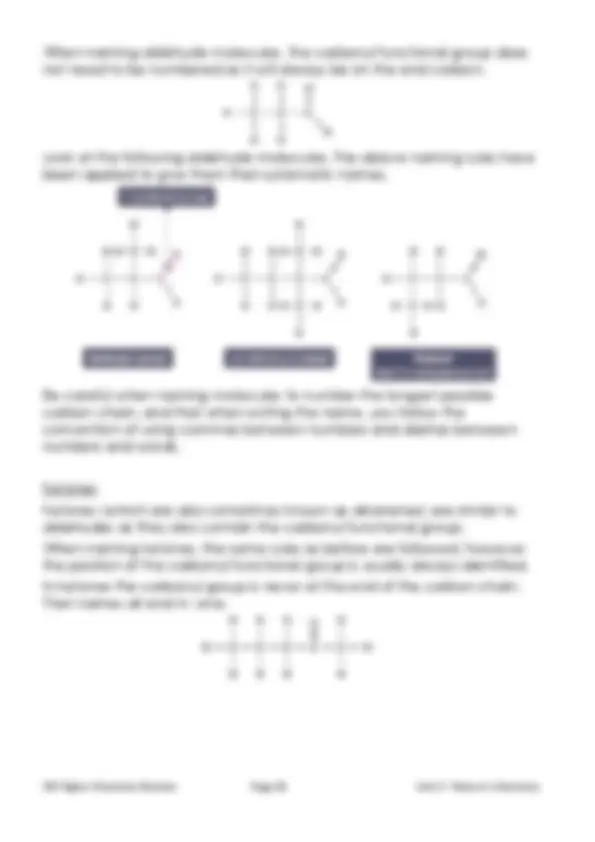
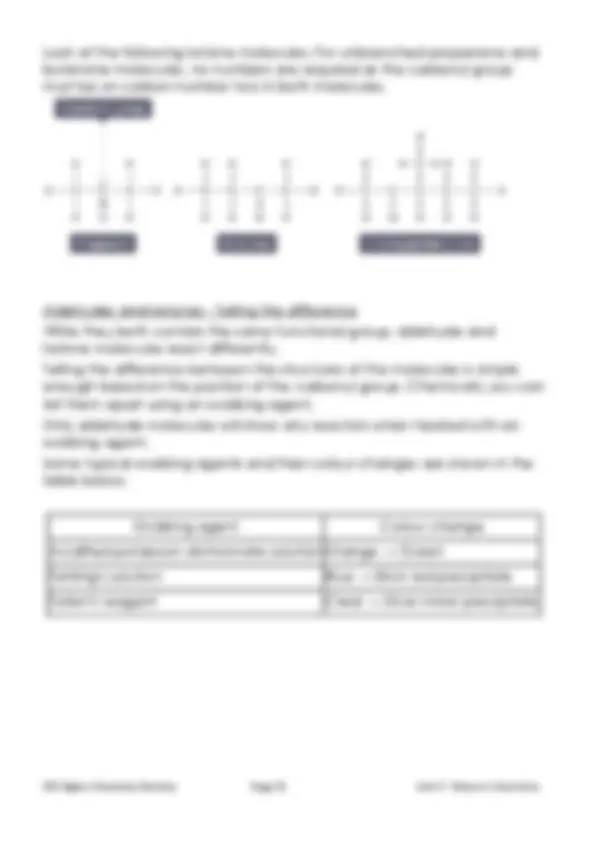
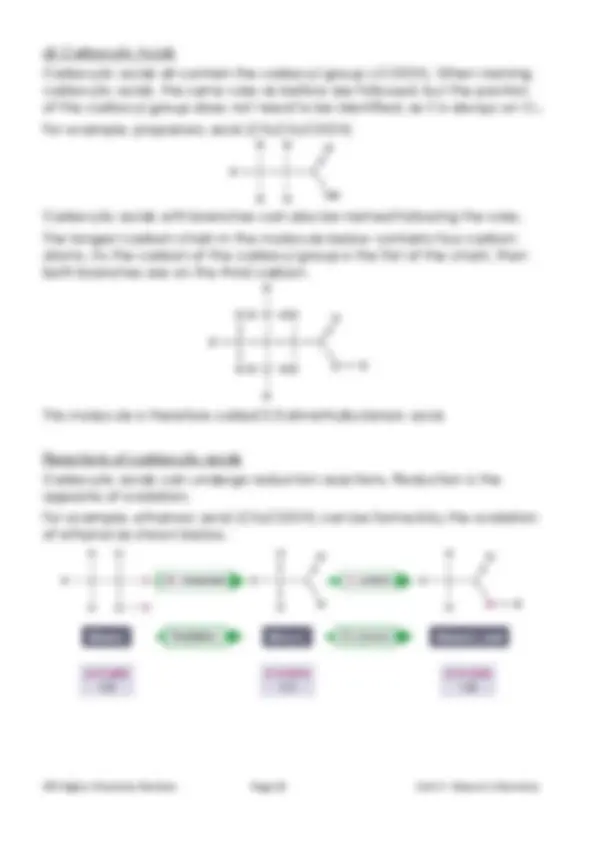
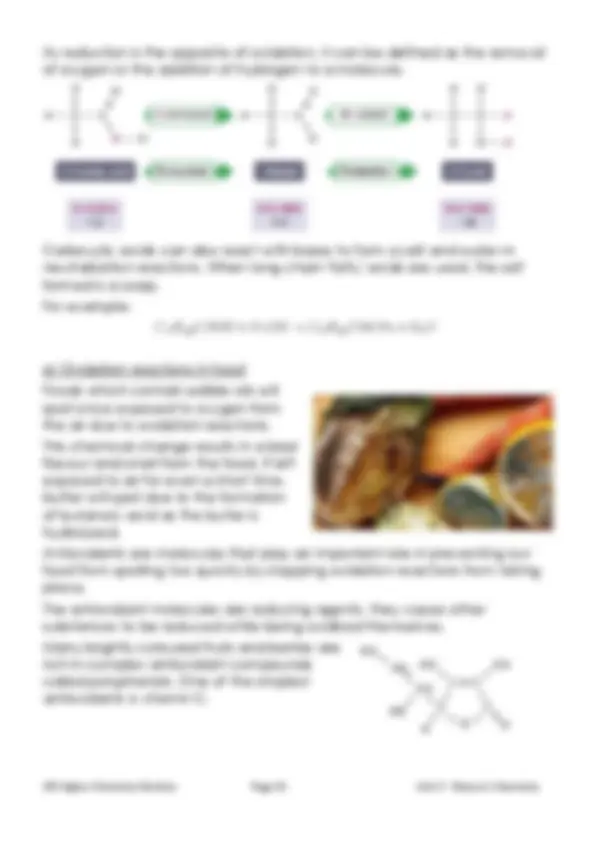
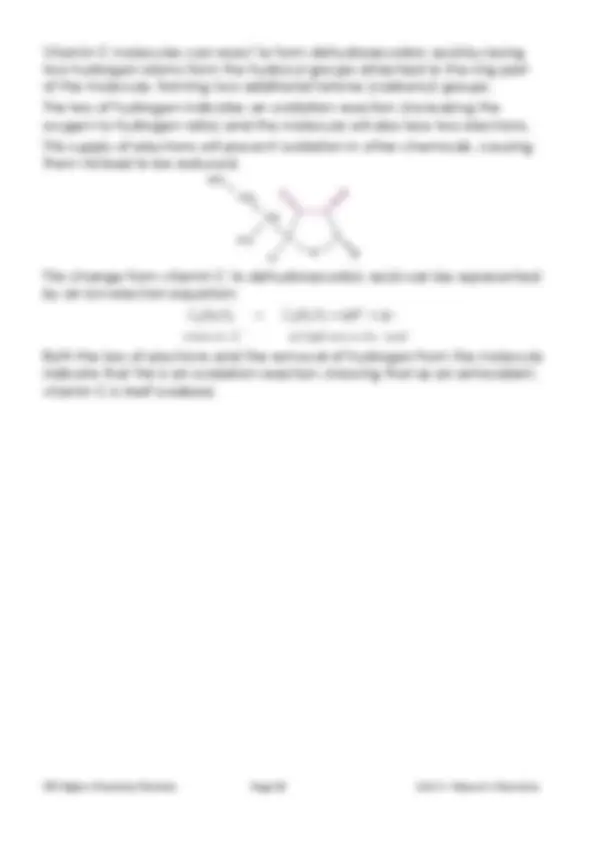
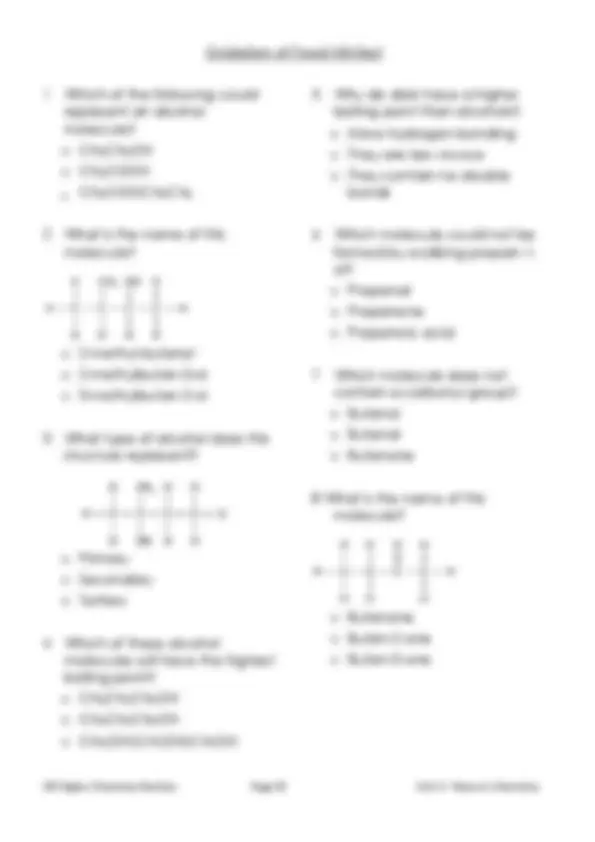
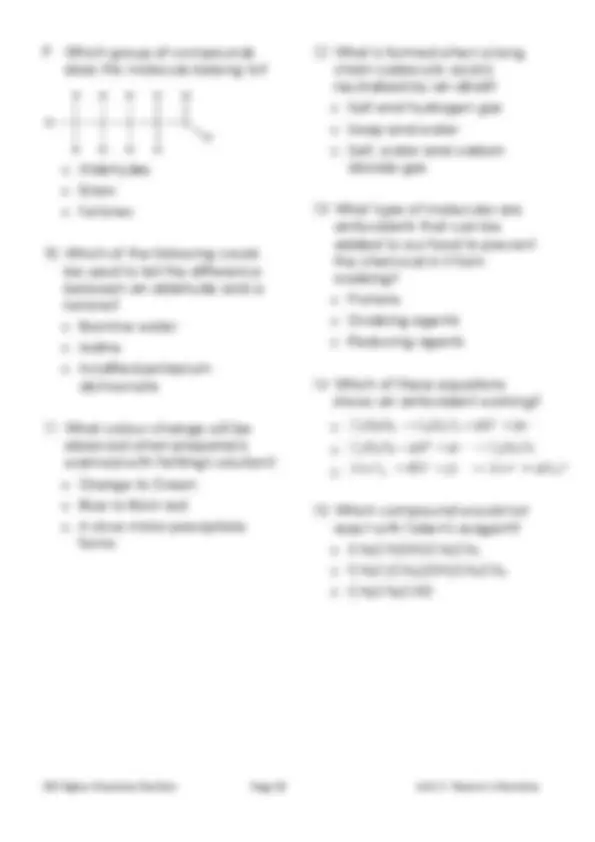
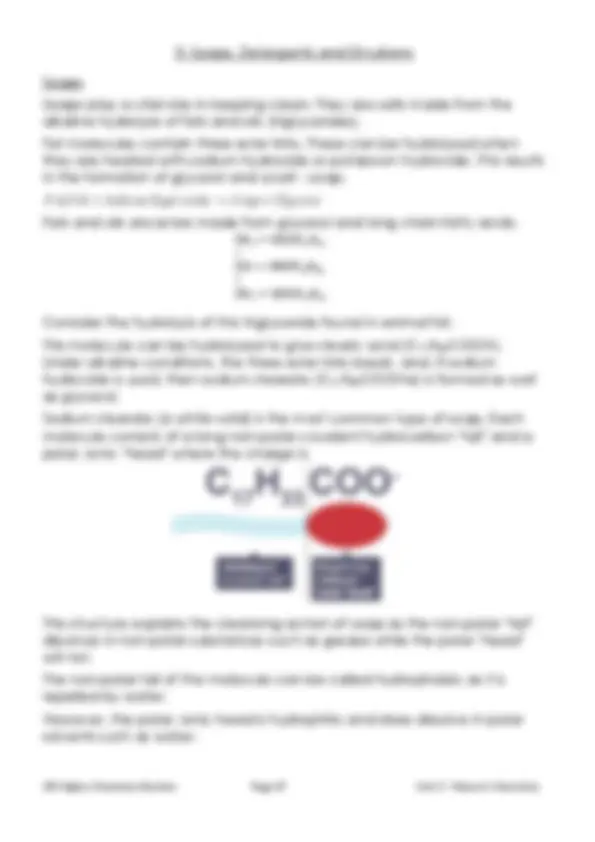
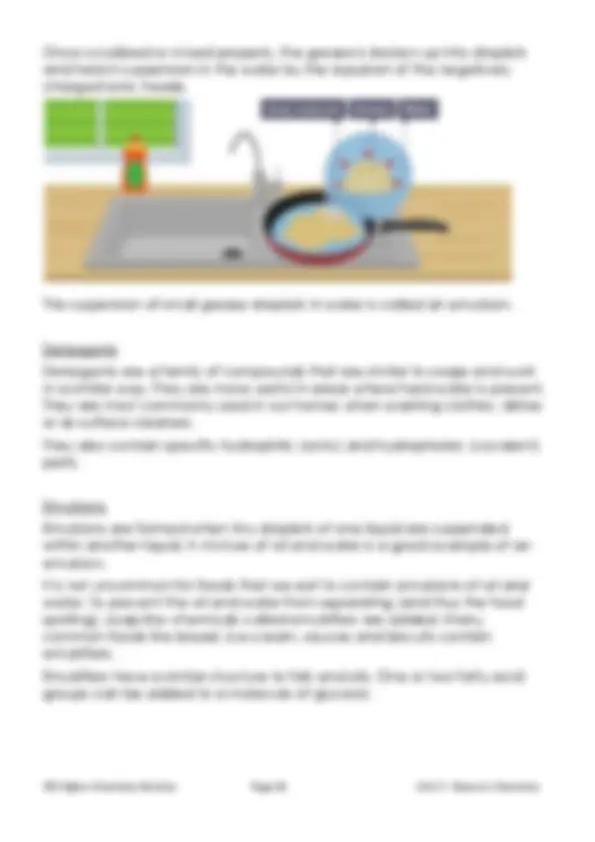
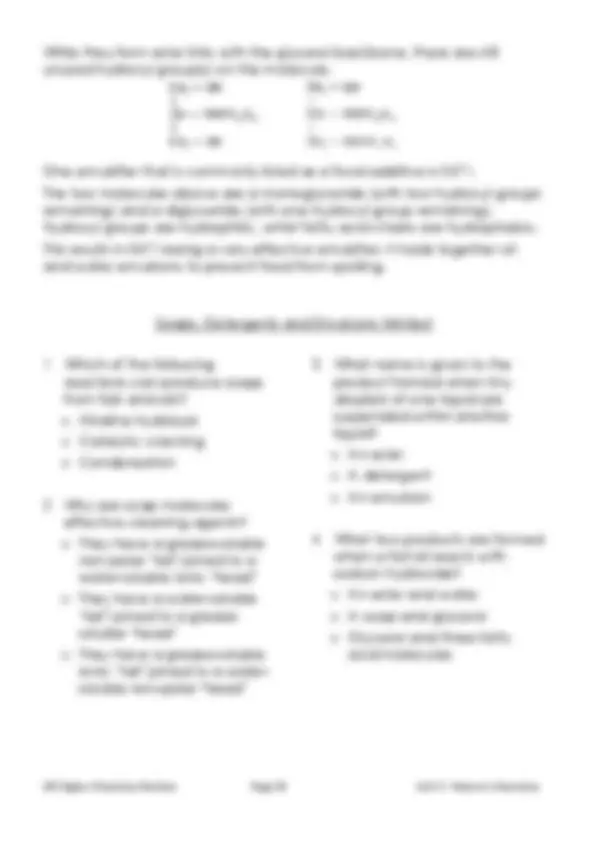
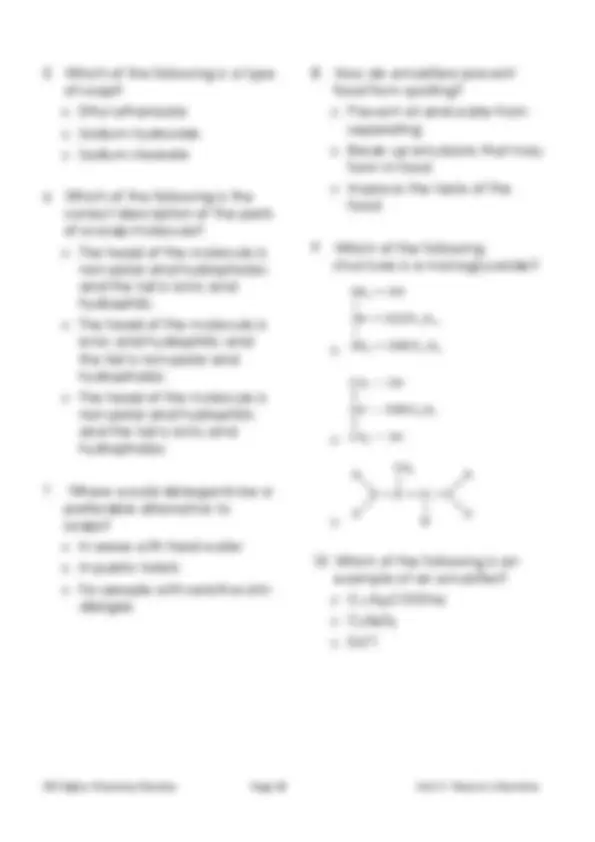
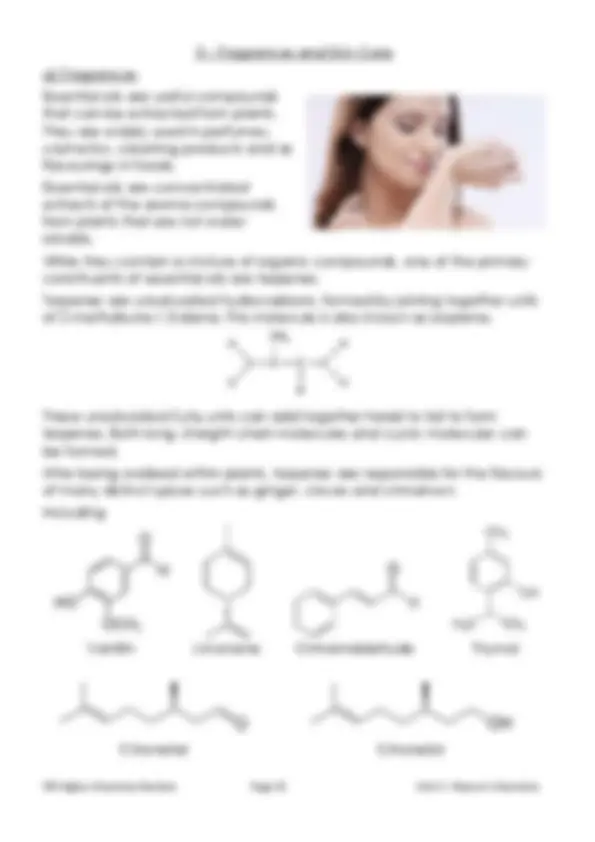
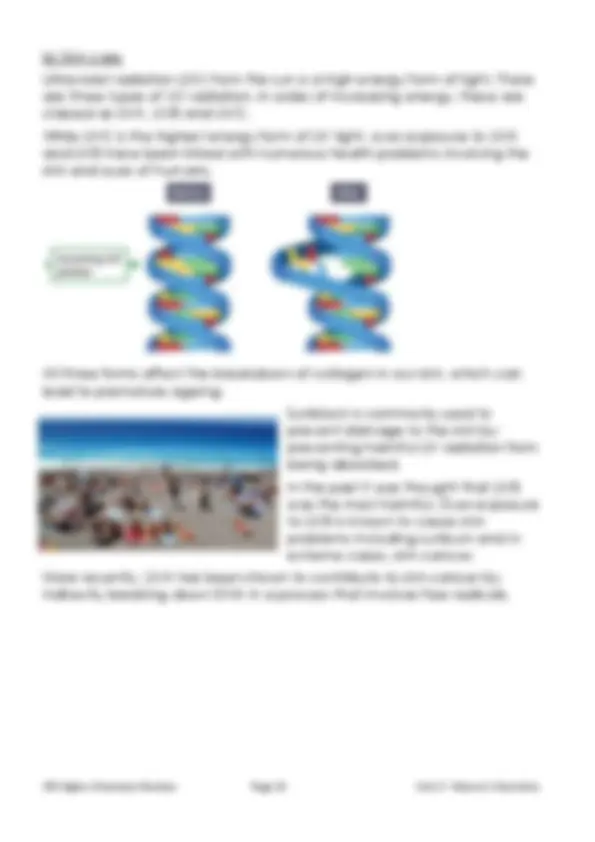
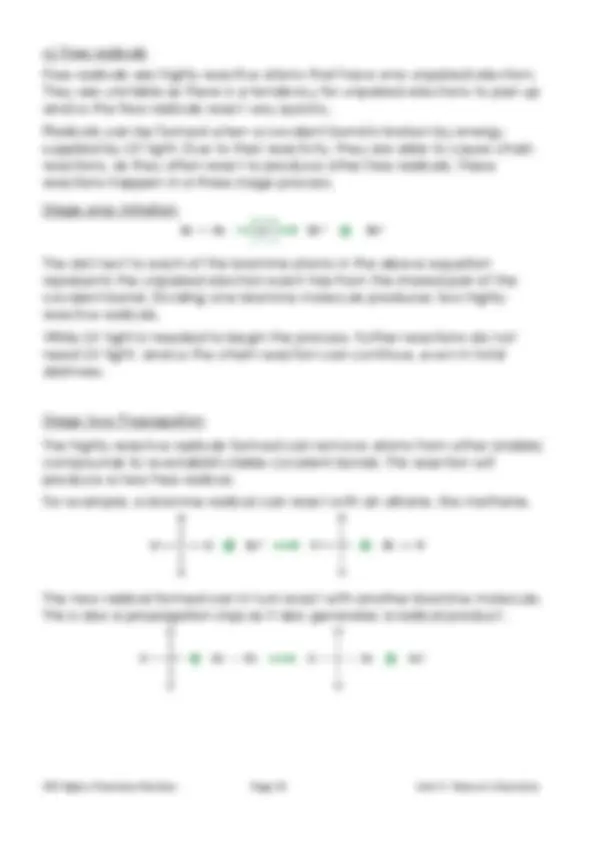
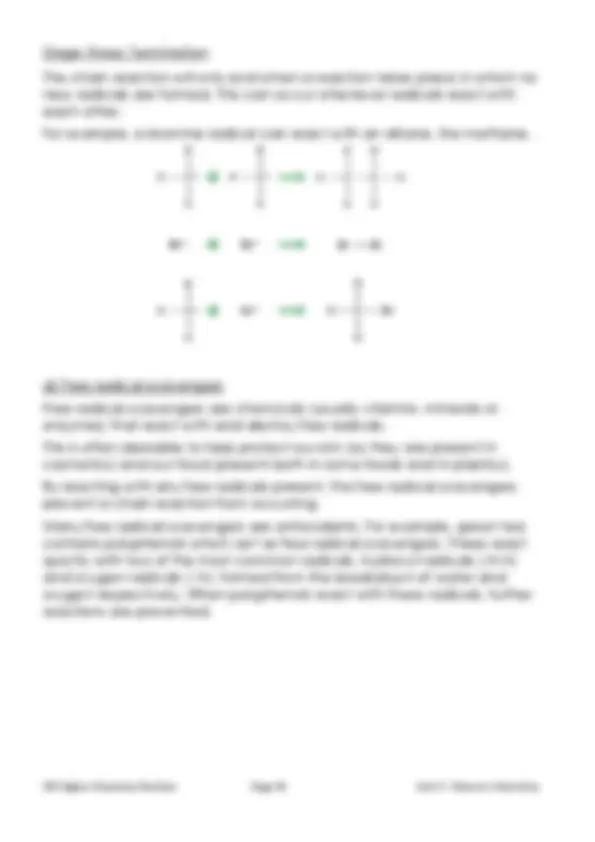
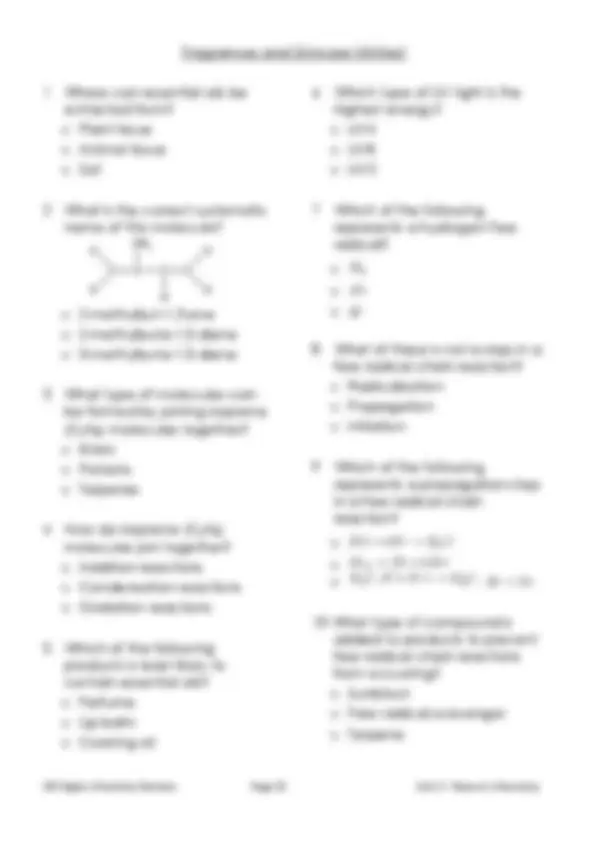
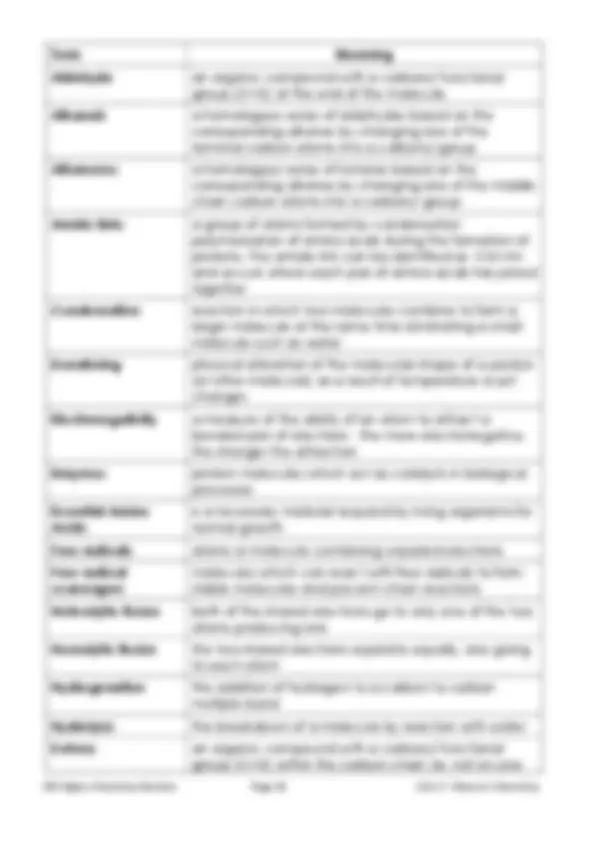
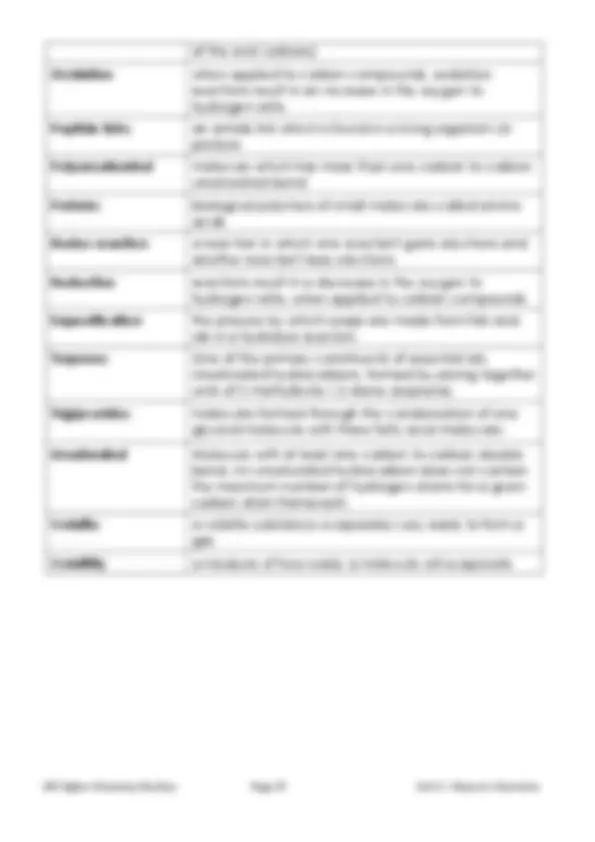


Study with the several resources on Docsity

Earn points by helping other students or get them with a premium plan


Prepare for your exams
Study with the several resources on Docsity

Earn points to download
Earn points by helping other students or get them with a premium plan
Community
Ask the community for help and clear up your study doubts
Discover the best universities in your country according to Docsity users
Free resources
Download our free guides on studying techniques, anxiety management strategies, and thesis advice from Docsity tutors
CfE Higher Chemistry Revision. Page 2. Unit 2 – Nature's Chemistry. 1 – Esters, Fats and Oils a) Esters. Esters are formed by the condensation reaction ...
Typology: Exercises
1 / 37

This page cannot be seen from the preview
Don't miss anything!






























1 – Esters, Fats and Oils
a) Esters
Esters are formed by the condensation reaction between an alcohol and a carboxylic acid. This is known as esterification. Esters have characteristic smells and are insoluble in water.
(means a reversible reaction)
They have the functional group:
The functional group (-COO) is known as the ester link. The main use of esters is for flavourings and perfumes, however they can also be used in the chemicals industry as solvents.
Structure of esters
To make an ester, a hydrogen atom must be removed from the hydroxyl group (–OH) of the alcohol.
The names and structures of some other esters are shown below.
Hydrolysis of esters
The breaking up of an ester can be achieved by heating the ester with an alkali such as sodium hydroxide.
This is an example of a hydrolysis reaction (the opposite of a condensation reaction) as a water molecule is added and breaks up the structure.
b) Fats and oils
Fat and oil-based food products
Fats and oils are used in our diets to provide us with energy. They play an important role in the transport of vitamins which are soluble in fats around the human body.
Many fats and oils are obtained from plant sources (sunflower oil, palm oil, coconut oil) and animal sources (lard, cod liver oil).
Structure of fats and oils
All fats and oils are naturally occurring esters, formed from condensation reactions between the alcohol glycerol and different long chain carboxylic acids (fatty acids). Glycerol is also known by its systematic name propane- 1,2,3-triol. It is a triol, meaning that it has three hydroxyl functional groups.
glycerol
Fatty acids are long chain carboxylic acids ranging from C 4 to C 28. Com-
mon fatty acids including stearic acid and oleic acid have eighteen car-
bon atoms in their chains.
The acid molecules can either be saturated or unsaturated. The fats and oils formed are also known as triglycerides. Like other esters, fats and oils are formed by a reversible reaction.
Esters, Fats and Oils Minitest
1 Methanol + ethanoic acid methyl ethanoate + water.
What type of reaction is this an example of?
2 Which of the following products are most likely to contain esters?
3 Which of these structures shows the ester ethyl methanoate?
4 What is the name of the ester formed when butanol and ethanoic acid react together?
5 What is the name of this molecule?
6 Why do fats have a higher melting point than oils?
saturated than oils
point than oils
than fats
7 What is the ratio of glycerol molecules to fatty acid molecules that are produced when a fat/oil is hydrolysed?
8 Glycerol can be obtained from fats by which process?
9 Which of the following is the structural formula for glycerol?
10 Which of the following is the name for the reaction when vegetable oils are “hardened”?
Essential amino acids
Different amino acid molecules can be joined together in different orders within our bodies to form different proteins.
The body cannot make all the amino acids required to build different proteins. It relies on protein intake from our diet to supply the essential amino acids.
Amino acids can then be used in sequence to build up protein in the body.
Breaking down proteins
Similar to esters, protein molecules can be broken down by hydrolysis (the opposite of condensation). Water molecules break apart the peptide links of the protein molecule, leaving separate amino acid molecules.
Given the structure of a protein molecule, the structures of the amino acids used to form it can be shown by simply breaking every peptide link to leave amine and carboxyl groups.
Digestion of proteins
During digestion, enzymes in our bodies break the proteins we eat down into amino acids (by hydrolysis).
These amino acids are transported around the body by blood. In the bloodstream, condensation reactions build the amino acids up to produce proteins required by the body.
Proteins and food
When cooking or preparing meats, different temperatures must be used depending on how much protein is found in the tissue.
Tender, lean meats such as fillet steak must be cooked at lower temperatures to retain their texture. This is because the protein molecules in the meat will chemically change when exposed to heat.
While proteins are long, spiral molecule chains, there are two main types of protein molecules.
Fibrous proteins
These molecules are the major structural material of animal tissue and are found in animal hair, nails and muscle.
Fibrous proteins have their long, spiral chains folded to form long, thin shapes. They are strong and are generally insoluble in water.
Globular proteins
Globular proteins are molecules involved in the regulation of life processes. For example, haemoglobin, and certain hormones like insulin and enzymes are all examples of globular proteins.
They have their spiral chains folded intro spherical shapes and are generally soluble in water.
3 – Oxidation of Food
When chemicals in food are exposed to oxygen in the air, their chemical composition changes and they begin to break down.
Animal and plant tissues contain antioxidant molecules to prevent this from happening. These molecules can slow the rate of oxidation in our foods.
But left unattended, foods will lose their nutritional value as they begin to discolour and break down.
a) Alcohols
Alcohol molecules all contain the hydroxyl (-OH) functional group. They are a homologous series and have the general formula CnH2n+ 1 OH. Their names all end in -ol.
The rules for naming an alcohol are:
This simple alcohol molecule is called butan-2-ol.
The names, molecular and structural formulae of some straight chain alcohols are shown in the table below.
When naming branched chain alcohols, be careful to number the longest possible carbon chain first.
When writing the name, you follow the convention of using commas between numbers and dashes between numbers and words.
Properties of alcohols
Compared with alkanes, alcohols have significantly higher boiling points. The hydroxyl groups in alcohol molecules are responsible for hydrogen bonding between the alcohol molecules.
As greater energy is required to overcome these strong intermolecular forces, the melting points and boiling points of alcohols are higher than those of alkanes with a corresponding chain length.
Alcohols with a greater number of hydroxyl groups will have even higher boiling points. When an alcohol has two hydroxyl groups it is called a diol. A molecule with three hydroxyl groups is a triol.
Compare these three molecules:
The large increase in the boiling point of alcohols as the number of hydroxyl groups increases is caused by a greater degree of hydrogen bonding between the molecules.
b) Oxidation of alcohols
The partial oxidation of an alcohol can be brought about by using an oxidising agent.
Some typical oxidising agents are:
acidified potassium dichromate solution acidified potassium permanganate solution hot copper (II) oxide (black solid) Benedict’s reagent Tollen’s reagent (silver-mirror)
Primary alcohols
Oxidation of primary alcohols forms two products in a two stage reaction.
When carbon compounds are oxidised, the oxygen to hydrogen ratio increases, so either oxygen atoms are being added to the compound, or hydrogen atoms removed.
The first stage oxidation of a primary alcohol involves the molecule losing two hydrogen atoms to form an aldehyde.
Consider the oxidation of propan-1-ol.
Stage one
Stage two
In the second stage, oxygen is added to the aldehyde molecule to form a carboxylic acid.
c) The Chemistry of Cooking
Many common flavours from different foods are caused by molecules within the foods called aldehydes and ketones.
Both of these molecules contain the same functional group (the carbonyl group) and are named in similar ways.
Aldehydes
Aldehyde molecules (which are also sometimes known as alkanals) have their carbonyl functional group (C=O) at the end of the carbon chain. Their names all end in -al.
Naming any molecule is straightforward if you follow these rules:
When naming aldehyde molecules, the carbonyl functional group does not need to be numbered as it will always be on the end carbon.
Look at the following aldehyde molecules. The above naming rules have been applied to give them their systematic names.
Be careful when naming molecules to number the longest possible carbon chain, and that when writing the name, you follow the convention of using commas between numbers and dashes between numbers and words.
Ketones
Ketones (which are also sometimes known as alkanones) are similar to aldehydes as they also contain the carbonyl functional group.
When naming ketones, the same rules as before are followed, however the position of the carbonyl functional group is usually always identified.
In ketones the carbonyl group is never at the end of the carbon chain. Their names all end in -one.